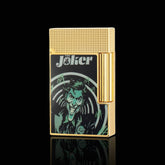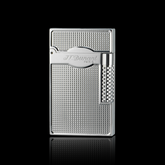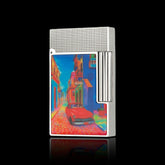Flame Types and Adjustment Mechanisms in JT Dunant Lighters: A Technical Overview
Introduction
JT Dunant lighters are recognized for their precision engineering and reliability. While their exterior may be sleek and stylish, it's the internal flame systems and adjustment mechanisms that truly define their functionality. Understanding these technical aspects not only enhances user experience but also ensures the lighter’s performance over time.
In this guide, we will examine the common flame types—Soft Flame and Dual Flame—as well as explore how to properly adjust and maintain them.
Section 1:Common Flame Types and How to Adjust Them
1. Single Soft Flame
Best for: Indoor use, lighting cigarettes or paper.
Adjustment:
Adjustment Wheel: Located at the base. Turn clockwise to increase flame size, counterclockwise to reduce.
Gas Pressure: Keep pressure consistent to avoid flickering or unstable flames.
Fine-tuning: Some models offer advanced adjustment for better flame control. Refer to model-specific manuals.

2. Dual Soft Flame
Best for: Users needing both precision and power.
Adjustment:
Allows simultaneous adjustment of soft flames.
Ensure even gas distribution.
May require specific instructions per model.

Section 2:Adjustment Mechanism and Gas Pressure Systems
The adjustment wheel is a marvel of engineering precision. While it offers users the flexibility to customize their flame, it’s essential to handle it with care. Over-tightening can result in calibration issues or even long-term damage.
Pressure regulation is equally crucial. Incorrect pressure settings can lead to inefficient combustion or even compromise the lighter’s integrity. Some flagship models feature pressure sensors that enable automatic adjustments, further enhancing the user experience.
About lighter, the ability to discern between flame types and adjust them appropriately is more important—it’s an essential feature that underscores the investment in a JT Dunant lighter. By equipping yourself with the knowledge to adjust these flames, you not only ensure your lighter’s longevity but also elevate every moment you use it.
Section 3:Technical Construction and Safety Features
Materials Used
- Brass: Durable and corrosion-resistant, used in main components.
- Stainless Steel: Withstands high temperature and mechanical stress.
- Rubber Seals: Prevent gas leaks and ensure safety.
Safety Features
- Pressure Valves: Prevent overpressure and gas leakage.
- Auto Shut-off: Stops gas flow if anomalies are detected.
These features are integrated during the design phase to function seamlessly with the rest of the lighter’s mechanics.
Section 4:Maintenance Tips and Common Mistakes
Recommended Practices
-
Regular Cleaning: Use compressed air and a microfiber cloth to clean the nozzle and adjustment area.
-
Use Quality Fuel: Stick to premium butane as recommended.
-
Proper Storage: Store in a dry, cool environment.
-
Annual Check-up: Visit a certified service center.
- Check Seals: Inconsistent flame may indicate a leak.
Mistakes to Avoid
- Over-tightening the Adjustment Wheel: While it might be tempting to achieve the ‘perfect’ flame, over-tightening the wheel can damage its calibration or the mechanism itself.
- Using Improper Tools: Never resort to makeshift tools, like knives or screwdrivers, to adjust the flame or disassemble the lighter. These can cause scratches or internal damages.
- Neglecting Safety Features: JT Dunant lighters come equipped with myriad safety features. It’s crucial to understand and respect these, ensuring not just the longevity of the lighter but also the safety of the user.
- Ignoring Fuel Quality: While it may seem cost-effective in the short term, using low-quality fuel can lead to clogging, inconsistent flame, and even damage to the adjustment mechanisms.
-
Infrequent Maintenance: Sporadic maintenance or ignoring the signs of wear and tear can result in decreased performance and even irreversible damages.
Conclusion
Mastering flame types and adjustment mechanisms is essential for efficient and safe use of your JT Dunant lighter. With proper knowledge and maintenance, these devices become more than just tools—they become reliable instruments built to last.
Whether you're a collector or a practical user, following the best practices and understanding the technical details will ensure your lighter performs at its peak for years to come.
Frequently Asked Questions (FAQs)
1.What are the common flame types in JT Dunant lighters?
The main flame types include Soft Flame (ideal for indoor use) and Dual Flame systems (offering both modes for flexibility).
2.How can I adjust the flame size properly?
Use the adjustment wheel at the base: turn clockwise to increase the flame, counterclockwise to decrease. Avoid overtightening to protect the calibration.
3.Why does the flame become unstable or fluctuate?
This may be caused by incorrect gas pressure, low-quality fuel, or worn-out seals. Check gas consistency and perform regular maintenance.
4.Can gas pressure be manually adjusted?
Most models use a fixed regulation mechanism. Select models feature automatic pressure sensors for real-time self-adjustment.
5.Is it safe to disassemble the lighter for repairs?
No. DIY disassembly can damage internal components. Always consult a professional or an authorized repair center for service.















